Uncovering Policies, Instruction, Practices, and Rules That Show Bias
“We didn’t buy in to the notion that kids must assimilate to the school structures at any cost.”

Steve Burnett, Ed.D., is a counselor and instructional team leader at Glenelg High School in Howard County. His experience includes being a pupil personnel worker, supervisor of school counseling, and assistant and interim principal.
As educators, we all know the synergy that is created when we work together for our students’ success. School counselors are an essential element for that success when we partner with teachers, administrators, paraprofessionals, and other school personnel.
As a team, we can close student achievement gaps, reduce institutional racism, and even self-evaluate biases and prejudices to create systemic change in our schools and communities.
Teaching Tolerance provides free resources to educators-teachers, administrators, counselors and other…www.tolerance.org
There are undeniable obstacles for many of our learners that are siphoned down to them through policies, curriculum choices, school districting, funding, and educator preparation, recruitment, retention, and pay. But when school staff work together, we can uncover and address policies, instruction, practices, and rules within our control that show overt institutional bias so that we can correct course.

This process is powerful and can unveil some remarkable findings by exposing the obstacles students face.
A student who is experiencing emotional difficulties, facing significant challenges for food or shelter, or having difficulties adjusting to cultural norms established by our educational system, may be at a disadvantage. But it doesn’t diminish their capacity or eagerness to learn.
Since schools function as a microcosm of the community, it’s important that all staff understand the current trends and issues within the community. With this knowledge, teachers and other instructional staff are prepared to have ongoing conversations about students with the child’s school counselor. These collaborative conversations may lead to a host of interventions for the child. Incorporating all of the interventions into a child’s individual academic plan can have a powerful influence on student acceptance and buy-in.
Strategies for K-12 Educators Critical Practices for Anti-bias Education offers practical strategies for accomplishing…www.tolerance.org
Let’s look at the plan in practice with a sample case: Ryan didn’t present as the typical student our education establishment speaks to. Ryan was a 17-year-old Hispanic student from poverty who is pierced and tattooed from head to toe.
He had the run of the streets, was drug involved, and was oppositional toward teachers — just the kind of student who gets left behind because he doesn’t fit into our model.

Counselors and teachers who advocate for all kids without bias develop individual academic intervention plans for kids like Ryan and wrap him in supports for success.
These plans may connect students with courses aligned to career interests, academic supports, counseling, interventions such as drug and alcohol programs, and anything else that might help each child find success.
We helped Ryan get food at school, we got him into AP art and business classes to prepare him to open his own tattoo shop, we connected him with an outside case manager to help with a drug and alcohol problem, and we built capacity for his teachers to understand the obstacles he faced. He responded, graduated, and with his family and counselor as support, was able to go to college and major in art.
Our school connected with Ryan without bias or prejudice — we didn’t buy in to the notion that kids must assimilate to the school structures at any cost.
It’s imperative that we understand the unintended impact our inherent biases have on our students. Perceptions are formed based on previous teaching and training, past experiences, and cultural messages. As adults and students, we make inferences about how we see the outside world that shape how we respond to it. By identifying our personal bias and institutional prejudices, and individualizing our instruction, we can create systemic change.

